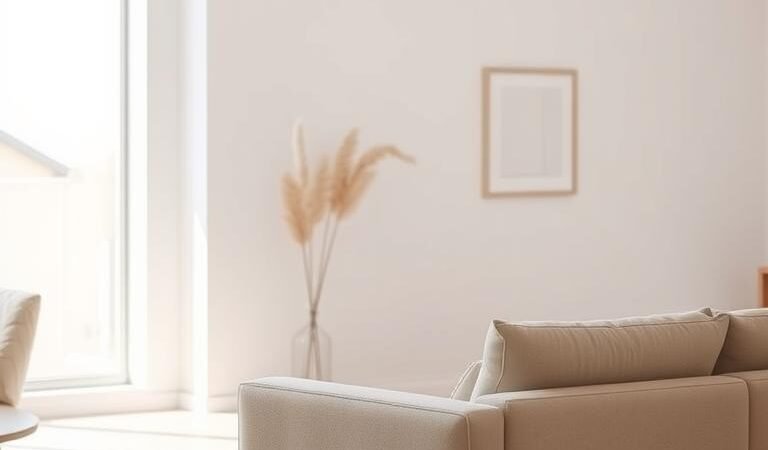Simple, intentional living spaces create calm in today’s busy world. This design philosophy focuses on what truly matters—clean lines, functional pieces, and open spaces. It’s not just about looks; it’s a lifestyle that brings clarity and peace.
Many homeowners now embrace this approach to transform their spaces. From sleek kitchens to cozy bedrooms, every room benefits from thoughtful choices. The result? A home that feels both stylish and serene.
This guide highlights 15 curated ideas to refresh your space. You’ll find tips for living rooms, kitchens, and outdoor areas. Each suggestion balances beauty with practicality, making upgrades easy and impactful.
Key Takeaways
- Minimalist design blends simplicity with purpose for a calming home.
- Open spaces and clean lines help reduce stress and clutter.
- Functional furniture enhances both style and daily living.
- Neutral colors and natural textures create timeless appeal.
- Small changes, like decluttering, make a big difference.
1. The Essence of Minimalist Design
Great design begins when you strip away the unnecessary. This philosophy, championed by architect Ludwig Mies van der Rohe, proves that “less is more” isn’t just a slogan—it’s a blueprint for living. By focusing on essential elements, spaces gain clarity and purpose.
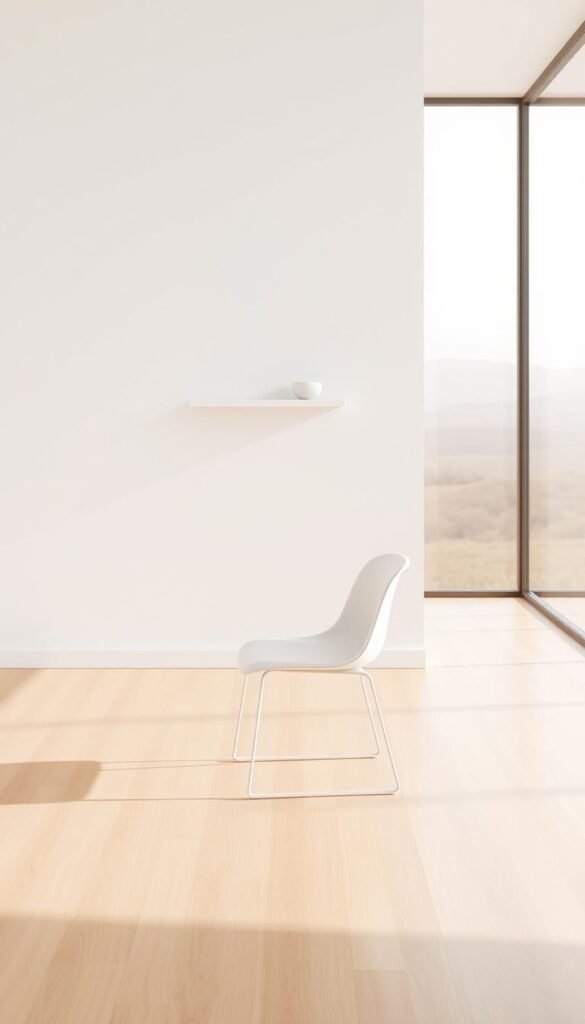
Less Is More: Core Principles
Modern minimalism traces its roots to the Bauhaus school’s influence, where function dictated form. Take the Gestalt New York SJ.15-3 Flamingo Sofa: its clean lines and lack of ornamentation embody this ideal. Similarly, the Aqueduct modular sofa adapts to 24 configurations—proof that simplicity doesn’t sacrifice versatility.
Key principles include:
- Visual weight: Tapered legs on the Sibast No 7 bar stool create lightness.
- Material honesty: Solid oak in the Alken Bed Frame celebrates natural textures.
- Intentional emptiness: Jung Lee NY’s decor philosophy favors “enough” over excess.
Why Minimalism Creates Peaceful Spaces
Studies show uncluttered environments reduce stress by 30%. The Lyra Armchair demonstrates this—its ergonomic curves offer comfort without visual noise. Bea Johnson’s zero-waste principles extend the mindset beyond decor, advocating for purposeful consumption.
| Minimalist Approach | Maximalist Approach |
|---|---|
| Prioritizes function (e.g., Bond Shelving System) | Embraces decorative abundance |
| Uses neutral tones for calm | Relies on bold colors for energy |
| Reduces items to essentials | Layers textures and patterns |
Spaces that feel intentional invite relaxation. Whether through modular furniture or monochromatic palettes, minimalist design transforms houses into sanctuaries.
2. Minimalist Inspiration for Living Rooms
Living rooms become sanctuaries when designed with purpose and restraint. Every piece should serve a function while enhancing the room’s flow. From sofas to shelving, intentional choices create harmony.
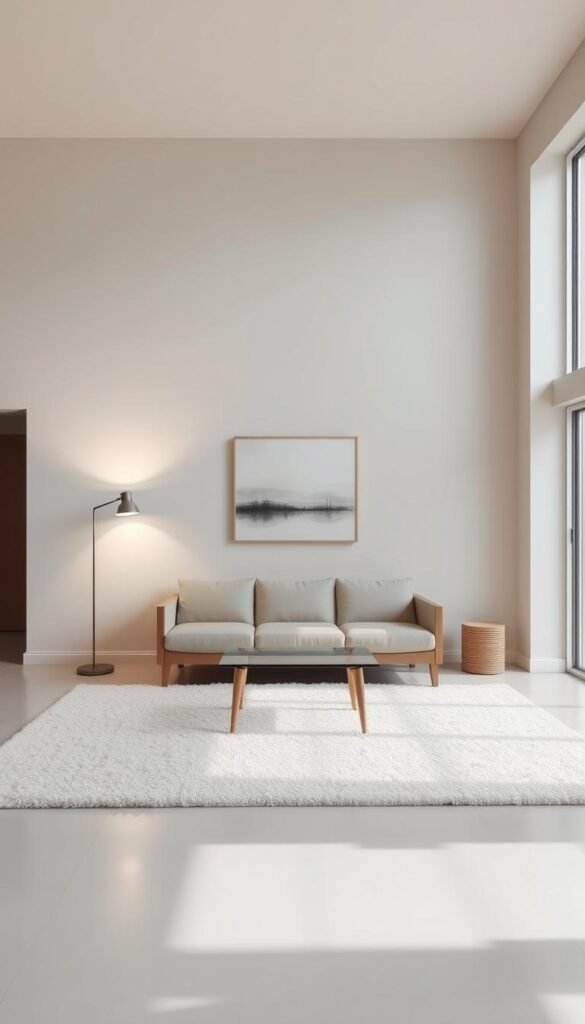
Anchor with a Simplistic Sofa
The SJ.15-3 Flamingo Sofa exemplifies minimalist anchoring. Its low profile and clean lines prevent visual clutter in open-concept spaces. Position it facing natural light sources to amplify the room’s airy feel.
Kate Marker Interiors suggests pairing it with a linen throw and oak side table. This combo balances soft textures with organic warmth. Avoid overcrowding—leave 18–24 inches of walking space around seating areas.
Modular Seating for Flexible Spaces
Small apartments thrive with adaptable furniture like the Aqueduct modular system. Its 24 configurations fit everything from movie nights to solo reading nooks. Compare layouts:
| Modular Seating | Traditional Seating |
|---|---|
| Saves 30% more floor space | Fixed shapes limit rearrangements |
| Grows with lifestyle changes | Often requires replacement |
| Encourages social clustering | May isolate guests |
Room & Board’s storage ottomans add hidden functionality. Tuck away blankets or books to maintain clean sightlines.
Neutral-Toned Armchairs
The Lyra Armchair blends Scandinavian comfort with muted hues. Neutral colors like taupe or dove gray reduce visual noise, fostering calm. Louis Duncan-He recommends placing armchairs near windows to reflect natural light.
Desiree Burns Interiors curates shelves with matching oak accents. Display only meaningful items—a ceramic vase or a single art book—to sustain balance.
3. Streamlined Kitchen Decor
Clean, functional kitchens blend beauty with practicality for everyday ease. This space benefits most when every element serves a purpose—from storage to surfaces. Thoughtful choices create harmony between workflow and visual calm.
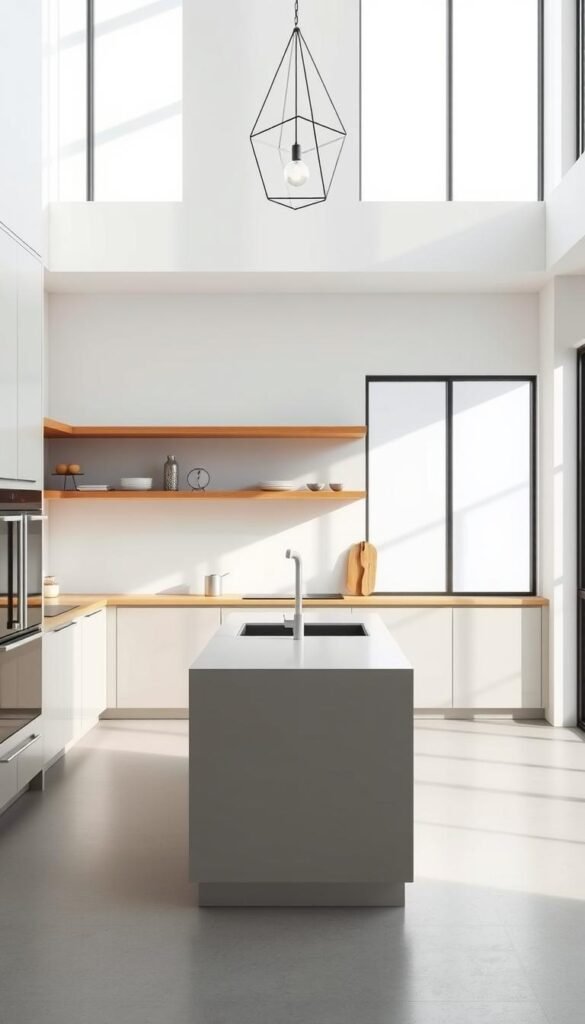
Open Shelving Over Cabinets
Jenn Pablo Studio proves upper cabinets aren’t mandatory. Their black Shaker pieces pair with open shelves for curated displays. Jung Lee’s herb arrangements add organic warmth while keeping essentials accessible.
Maintenance matters: dust weekly and group items by use. JLA Designs’ case study shows veined stone backsplashes simplify cleaning. Recessed lighting, like Jill Howard’s approach, eliminates shadowy corners.
Monochrome Bar Stools
The Sibast No 7 stool embodies Danish Modern style with clean lines. Its tapered legs and oak seat complement neutral palettes. Bea Johnson suggests choosing stools with hidden storage for zero-waste efficiency.
Compare options:
| Handleless Design | Visible Hardware |
|---|---|
| Creates seamless flow | Adds industrial character |
| Easier to clean | Requires polishing |
Functional, Sleek Countertops
Ida Linea Hildebrand’s Saw Table demonstrates how materials impact utility. Quartz resists stains while mimicking natural stone. Keep surfaces clear with these tips:
- Install pull-out spice racks
- Use magnetic strips for knives
- Choose integrated sinks
Veined patterns disguise crumbs between cleanings. A single fruit bowl or cutting board maintains the less-is-more ethos.
4. Serene Bedroom Retreats
Bedrooms transform into peaceful retreats with thoughtful design choices. Every element—from bed height to fabric textures—contributes to a restful atmosphere. This haven balances aesthetics with functionality, proving less truly enhances more.
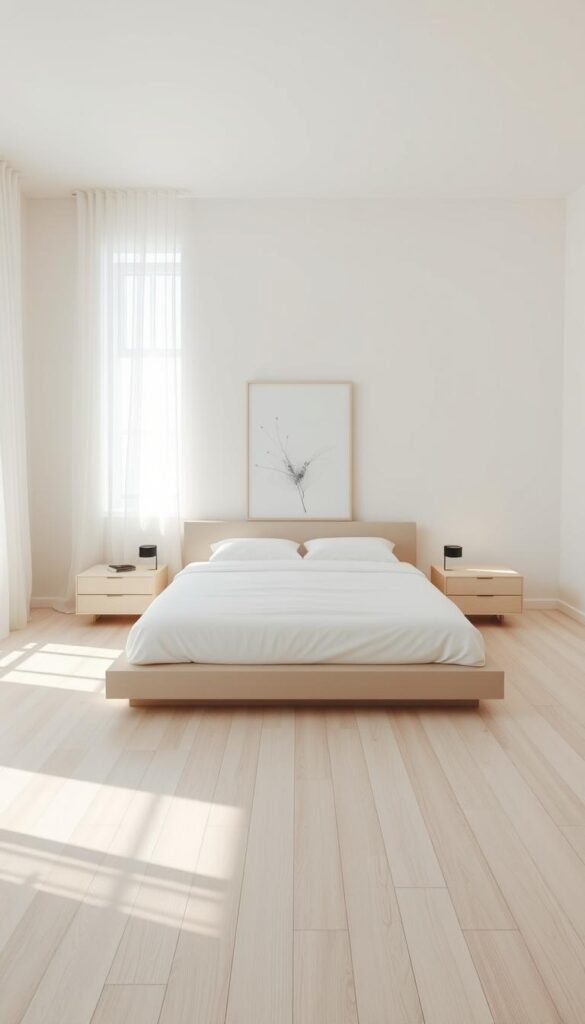
Low-Profile Bed Frames
The Alken Bed Frame showcases solid oak’s natural beauty. Its 8-inch height suits small rooms, while the wood grain adds organic warmth. Project Nord suggests measuring 18 inches from floor to mattress top for ideal proportions.
Under-bed storage maximizes space without clutter. Use shallow bins for seasonal items, maintaining the frame’s clean lines. This approach aligns with Marie Kondo’s vertical folding principles for nearby dressers.
Neutral Textiles for Calm
Becca Interiors layers crisp linen sheets with textured wool throws. A monochromatic color scheme in taupe or ivory creates visual harmony. Consider these combinations:
- Organic cotton duvet + cashmere lumbar pillow
- Bamboo rug + flax curtain panels
- Stonewashed linen headboard + felted wool blanket
Blackout shades suit light-sensitive sleepers, while sheer panels maintain airiness. Symmetrical bedside lamps, per The Home Consultant, enhance balance.
Curated Nightstand Essentials
Limit surfaces to three purposeful items: a reading light, water carafe, and small tray. The Minimalists advocate 12 inches of clear space around each object. Floating shelves keep floors unobstructed, amplifying the room’s open feel.
Choose multi-functional pieces like Project Nord’s ceramic-valet combo. Its integrated catchall holds watches while doubling as decor. This mindful approach turns bedtime routines into rituals of calm.
5. Minimalist Dining Spaces
Dining areas shine when form meets function in perfect harmony. The right table, lighting, and tableware create inviting space for meals and memories. This balance elevates everyday dining into a curated experience.
Sleek Tables with Clean Lines
The Fiori Coffee Table embodies sculptural minimalism with its oval glass top and ash wood base. For smaller rooms, the Saw Table/2 Parts offers modular functionality—its sections separate for casual breakfasts or combine for dinner parties.
Follow these proportion principles:
- Allow 36 inches between table edge and walls for chair clearance
- Choose 28-30 inch heights for standard seating
- Round tables improve flow in square rooms
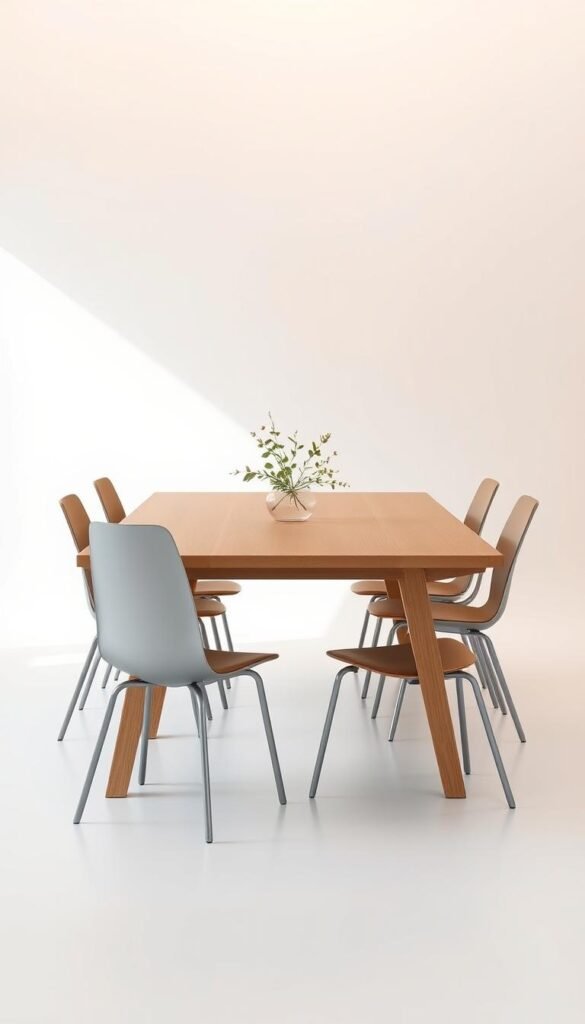
Understated Tableware
Jung Lee crafts centerpieces using foraged branches and hand-thrown stoneware. Monochromatic styling works best:
| Material | Advantage |
|---|---|
| Porcelain | Reflects light for airy feel |
| Textured stoneware | Adds organic warmth |
| Recycled glass | Suits multi-gen households |
Mix materials intentionally—pair matte ceramic plates with polished flatware for subtle contrast.
Lighting as a Focal Point
Beaubien Atelier’s waterfall-inspired pendants cast ambient glows. Consider these placement strategies:
- Hang 30-34 inches above table surface
- Use dimmers to adjust for formal vs casual meals
- Cluster smaller fixtures over long tables
Brushed nickel finishes reduce glare, while matte black lighting makes bold statements. The right glow turns meals into moments.
6. Bathrooms with a Spa-like Feel
Bathrooms designed with restraint become personal sanctuaries of calm. Every element—from tile patterns to vanity height—contributes to this feel. The right materials and layout turn routine rituals into rejuvenating experiences.
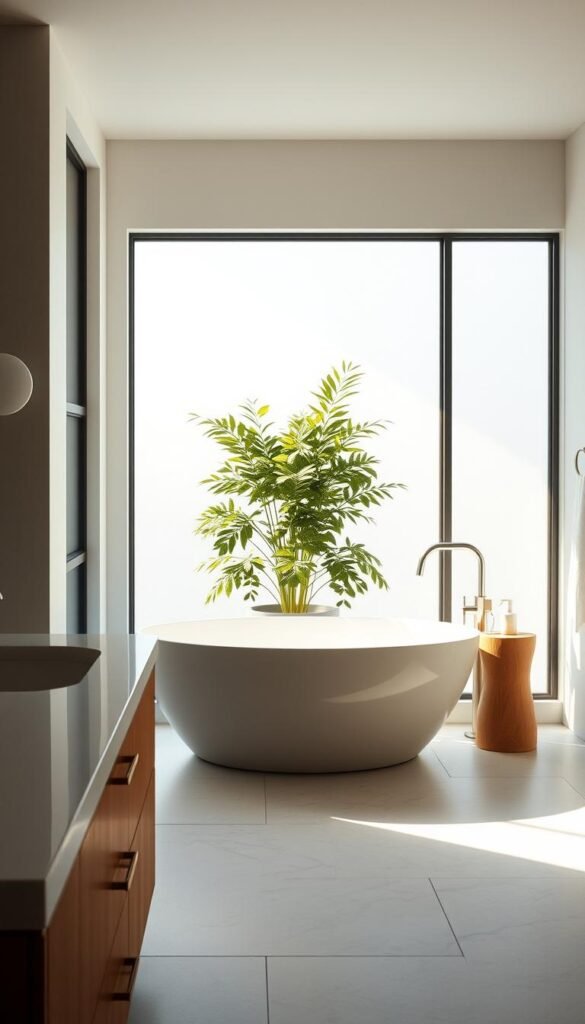
Floating Vanities
Rae Mirror’s frameless philosophy extends to wall-mounted vanities. These clean lines maximize floor space while simplifying cleaning. Consider these installation factors:
- Position 36 inches above floor for accessibility
- Choose integrated sinks for seamless looks
- Select matte finishes to minimize water spots
JLA Designs’ veined stone tops add organic texture. Their durability withstands daily use while whispering luxury.
Monochromatic Tile Patterns
Laura Brophy Interiors’ black-and-white schemes prove contrast needn’t mean clutter. For cohesive looks:
| Tile Strategy | Visual Impact |
|---|---|
| Matching grout colors | Creates seamless expanses |
| Large-format tiles | Reduces visible lines |
Extend the same tile from floor to shower for continuity. This Scandinavian-style approach makes small bathrooms appear larger.
Minimalist Storage Solutions
Hidden storage compartments maintain serenity. Try these anti-clutter strategies:
- Recessed medicine cabinets with fog-resistant mirrors
- Narrow pull-out towers for toiletries
- Heated towel racks that double as drying stations
For humidity-resistant materials, choose teak shower benches and sealed concrete floors. Every solution should serve multiple purposes without visual noise.
7. Outdoor Spaces in Harmony with Nature
Outdoor spaces thrive when designed to complement nature’s rhythm. The right pieces create seamless transitions from indoor comfort to open-air serenity. Every choice—from materials to layout—should enhance the natural environment.

Unobstructed Open-Air Seating
The RIB Lounge Sofa demonstrates perfect balance with its teak slats and stainless steel frame. This wood and metal combo withstands seasons while maintaining visual lightness. Bryce Langston’s tiny house solutions prove compact layouts can feel spacious with these strategies:
- Position seating 18 inches from glass doors for flow
- Use transparent acrylic side tables
- Choose low-back designs that preserve sightlines
Linear Benches for Simplicity
Straight-line seating maximizes usable space without clutter. Compare maintenance needs for common materials:
| Material | Care Routine | Lifespan |
|---|---|---|
| Powder-coated aluminum | Wipe monthly | 10+ years |
| FSC-certified teak | Oil annually | 15+ years |
| Recycled plastic | Hose down | 7-10 years |
Functional Outdoor Tables
Weather-resistant surfaces transform patios into dining destinations. The best designs share these traits:
- Drainage channels in tabletops prevent pooling
- Adjustable feet compensate for uneven ground
- Integrated storage hides cushions when not in use
Vertical gardens make natural dividers—try espaliered fruit trees or mounted succulent frames. For evening ambiance, 2700K LED lighting mimics sunset warmth.
8. Minimalist Storage That Blends In
Smart storage solutions turn clutter into calm without sacrificing style. The best designs disappear into walls or double as decor, maximizing space without visual noise. From consoles to shelving, every piece should serve multiple purposes seamlessly.
Low-Profile Consoles
The ATBO Low Console redefines entryway storage with customizable compartments. Its 12-inch height preserves sightlines, while oak panels add organic warmth. Consider these placement strategies:
- Align with artwork to create visual continuity
- Use felt-lined drawers for delicate items
- Add recessed LED strips for nighttime visibility
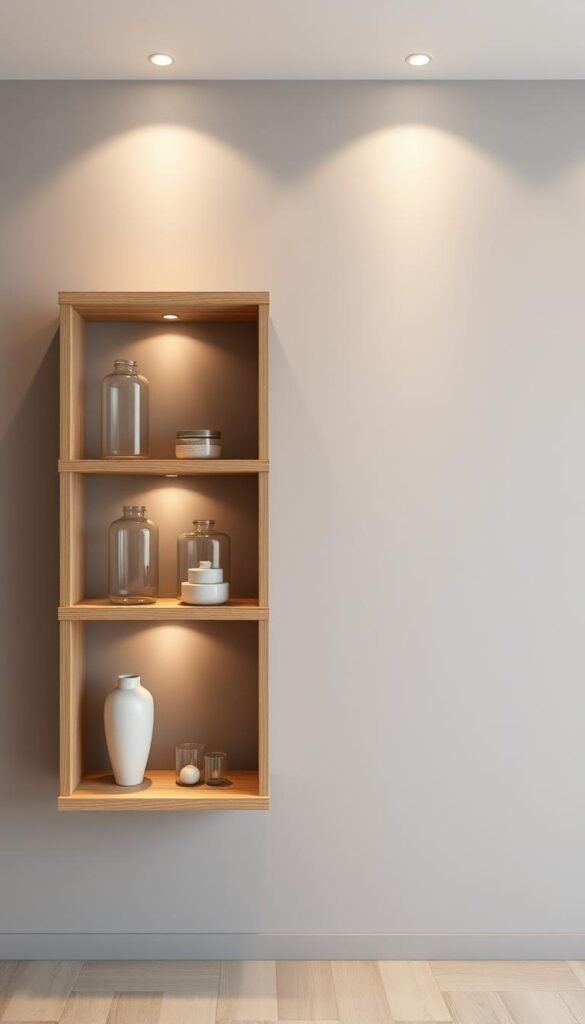
Wall-Mounted Shelving Systems
Bond Shelving System’s weight-distribution engineering supports 50 lbs per bracket. Ideal for small spaces, these shelves float above floors, easing cleaning. Compare installation types:
| Type | Weight Capacity | Best For |
|---|---|---|
| Drywall anchors | 20 lbs | Decor items |
| Stud-mounted | 75 lbs | Book collections |
| Cantilever brackets | 40 lbs | Display pieces |
Hidden Storage Hacks
Project Nord’s 30-Day Challenge inspires creative solutions. Try these ideas:
- Convert stair risers into pull-out drawers
- Install magnetic panels inside cabinet doors for spices
- Use ottomans with lift-up seats for toy storage
Jung Lee’s curation principle applies: “If it’s visible, it should spark joy.” For seasonal items, vacuum-sealed bags under beds save 80% more space than traditional bins.
9. Accents That Elevate Minimalism
Thoughtful accents refine a space without overwhelming its simplicity. These elements—textured rugs, curated art, and intentional objects—add depth while preserving clean lines. Each piece should feel essential, like a quiet note in a harmonious melody.
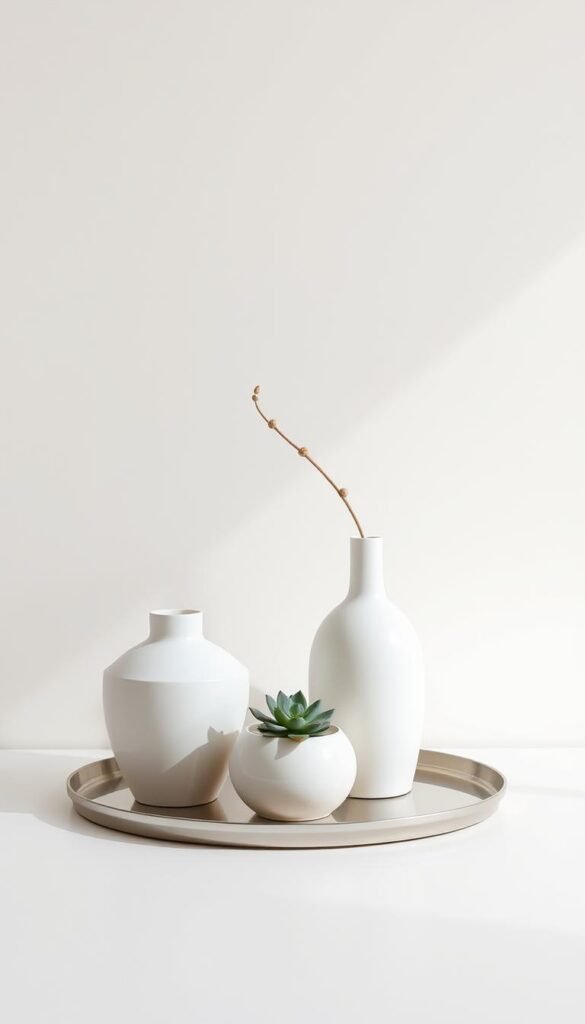
Subtle Textured Rugs
Gro Rug’s geometric patterns showcase how natural dyes and organic hemp fibers warm hardwood floors. For balance, match rug dimensions to seating areas:
- Small rooms: 5’x8’ with 12” floor border
- Open layouts: 8’x10’ under sofa front legs
Scandinavian-style rugs use tactile contrast—think chunky wool against smooth concrete. Jung Lee layers jute under sheepskins for earthy luxury.
Minimalist Wall Art
Jessica Vedel’s Rae Mirror exemplifies art as functional decor. Its frameless design reflects light without visual weight. Compare display approaches:
| Framed Art | Unframed Canvas |
|---|---|
| Adds structured elegance | Enhances organic feel |
| Works in formal spaces | Suits casual environments |
Project Nord’s posters follow the Rule of Thirds—hang 57” from floor to center for eye-level harmony.
Purposeful Decorative Objects
Room & Board’s odd-number principle applies: group three varied-height vessels on a console. Consider these objects with dual roles:
- Ceramic bowls that hold keys or succulents
- Handblown glass vases doubling as diffusers
For personal touches, rotate one memorabilium piece seasonally. A single childhood photo in a matte black frame feels intentional, not cluttered.
10. Conclusion: Embrace the Minimalist Mindset
Creating a peaceful home starts with choosing what truly matters. By focusing on intentional living, every piece in your space serves a purpose—whether it’s a functional sofa or a calming neutral palette. This approach isn’t about deprivation but clarity.
Start small with Project Nord’s 30-Day Challenge: declutter one area weekly. Studies show simplified design reduces stress by 30%. Bea Johnson’s zero-waste principles prove less stuff means more freedom.
Adapt the core ideas to fit your lifestyle. Try modular furniture for flexibility or open shelving for curated displays. Bryce Langston’s tiny house community demonstrates how mindful choices maximize comfort in any size home.
Remember, minimalism is a journey, not a strict rulebook. Let your living space evolve with you—each intentional change brings deeper calm and joy.
